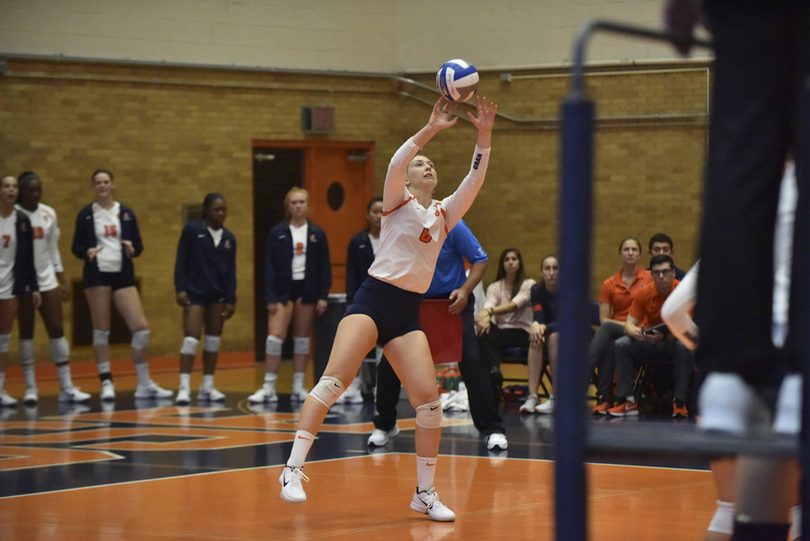Depth allows Syracuse’s offense to roll on despite injuries

Syracuse has been able to withstand numerous injuries due to a deep bench. Max Freund | Staff Photographer
When outside hitter Kendra Lukacs came up limping after landing awkwardly on her ankle against Pittsburgh on Sept. 22, Syracuse lost a player who had led its attack for a better part of a month.
As important as Lukacs is to the Orange offense, the team was well-equipped to deal with her injury because of its depth. Fellow outside hitter Ella Saada returned to an attacking role, and even though Lukacs has not played significant time since the injury, SU’s attack has rolled on.
The Orange (15-8, 7-3 Atlantic Coast) has dealt with significant injuries throughout the season. Setter Jalissa Trotter missed two weeks, Lukacs has played only a handful of points in the last month, and, in September, Anastasiya Gorelina played sparingly due to injury. SU’s depth has helped the team cope with these injuries, and it is a big reason why Syracuse has increased its offensive efficiency.
“Having depth definitely helps,” SU head coach Leonid Yelin said. “We’ve had a lot of injuries and of course it’s not ideal, but we have lots of players who can play well.”
With all of the different looks Syracuse can throw at an opposing front line, from the power of
Gorelina to the placement of Saada, SU has benefitted from keeping opponents guessing.
This season, SU has posted a .243 attack percentage, which is hits minus errors divided by attack attempts. That’s up from .176 last season. All of the players competing for just six spots on the floor has paved the way for competition within the team. Every starter has a backup fully capable of stepping in due to injury or subpar performance. When Trotter went down with injury, Annie Bozzo stepped in as main setter and averaged 36.6 sets per game in seven games.
“As a hitter, you have to mix up your shots,” Yelin said. “If you do the same thing every time, the other team will plan for it.”
While Saada nursed a shoulder injury early this season, she could only play defense. For a five-game stretch, she rotated in and out of the back line and did not even attempt a kill. In those games, Lukacs averaged 13.6 kills per game.
Fortunately for the Orange, Lukacs’ injury coincided with Saada’s return to the front line. Since re-entering the lineup with her right shoulder fully healthy, Saada has averaged nearly 10 kills per game.
“We were talking to the doctor and they said maybe it’s a good idea to work on her shoulder and not to play,” Yelin said. “That why she was helping us on defense. But now she’s a hitter again.”
At middle blocker, Santita Ebangwese is the centerpiece, but both Amber Witherspoon and Dana Gardner have seen a minutes increase, providing them a chance to prove themselves. Witherspoon registered 10 blocks in two games this past weekend, including seven in a four-set loss to Georgia Tech Friday night.
“Everyone should be pushing each other to get better and that’s how we get better as a team,” Lukacs said.
SU often spreads its attack offensively, as multiple players often register more than eight kills in almost every game. In a loss to Pittsburgh on Oct. 13, the Orange had four players with at least eight kills. Against Georgia Tech, the same held true: Four players registered eight kills, with three in double figures.
No matter who Yelin has called to step up off the bench this season in a moment’s notice, the Orange has responded.




